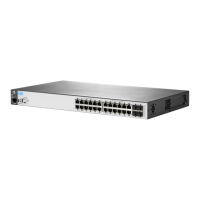NOTE: Mixing CLI-configured and RADIUS-assigned rate-limiting on the same port can produce
unexpected results. See “Per-port bandwidth override” (page 32).
When multiple clients are currently authenticated on a given port where outbound (egress)
rate-limiting values have been assigned by a RADIUS server, the port operates with the outbound
rate-limit assigned by RADIUS for the most recently authenticated client. Any earlier outbound
rate-limit values assigned on the same port for other authenticated client sessions that are still active
are superseded by the most recent RADIUS-assigned value. For example, if client "X" is authenticated
with an outbound rate-limit of 750 kbps, and client "Y" later becomes authenticated with an
outbound rate-limit of 500 kbps while the session for client "X" is still active, then the port operates
with an outbound rate-limit of 500 kbps for both clients.
Outbound rate-limitInbound rate-limit802.1pAssignment method on port 10
100,000 kbs
1
100,000 kbs7Statically Configured Values
50,000 kbs
1
10,000 kbs3RADIUS-assigned when client "X"
authenticates
1
Combined rate-limit output for all clients active on the port.
Figure 3 Results of client authentication on Port 4
Syntax:
show rate-limit all [port-list]
show qos port-priority
These commands show the CLI-configured rate-limiting and port priority for the
selected ports. They also include information on RADIUS-assigned rate-limiting and
client traffic priority settings for any clients that may be authenticated on the same
ports.
Configuring RADIUS server support for switch services 35

